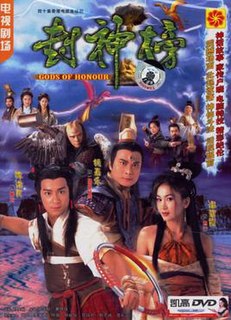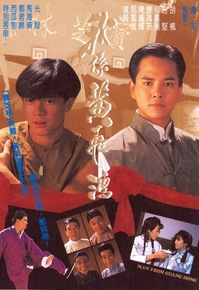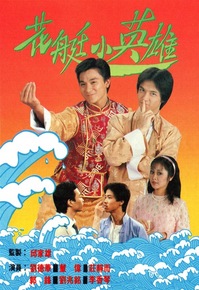
Wing Chun Kuen, usually called Wing Chun (詠春), is a concept-based traditional Southern Chinese Kung fu (wushu) style and a form of self-defense, that requires quick arm movements and strong legs to defeat opponents. Softness and performance of techniques in a relaxed manner is fundamental to Wing Chun.

Hung Ga (洪家), Hung Kuen (洪拳), or Hung Ga Kuen (洪家拳) is a southern Chinese martial art belonging to the southern shaolin styles. It is associated with the Cantonese folk hero Wong Fei Hung, a Hung Ga master.

Leung Jan was a Dit Da and Wing Chun practitioner from Heshan, Guangdong. He was known in Foshan as Mr. Jan of Foshan and King of Wing Chun Kuen.
Yim Wing Chun is a Chinese legendary character, often cited in Wing Chun legends as the first master of the martial art bearing her name. Wing Chun, though a person's name in Chinese language, translates literally to "spring chant", or may be substituted with the character for "eternal spring".

White Crane Style is a Southern Chinese martial art that originated in Yongchun County, Fujian (福建) province. According to oral tradition, the style was developed by Fang Qiniang, a female martial artist. It is associated with traditional fighting techniques, including long range, but is most similar to close-quarter or hand-to-hand combat. It is most recognizable by the way the fighter imitates a bird's pecking or flapping of wings. While some white crane styles make use of traditional weapons, others have discontinued the use of weaponry.
The different branches of the Chinese martial art of Wing Chun can be thought of as describing both the differing traditions and interpretations of Wing Chun, and the teacher-student relationships which perpetuate them.

Lam Sai-wing was a Hung Gar martial artist. He was a student of the Chinese martial artist, acupuncturer and folk hero of Cantonese ethnicity, Wong Fei-hung.
A list of awards given to members of the Hong Kong Civil Service:

The Prodigal Son is a 1981 Hong Kong martial arts comedy film starring Yuen Biao and directed by Sammo Hung, who also co-starred and wrote with Barry Wong. The film was released on 22 December 1981 and grossed HK$9,150,729. The Prodigal Son was nominated for two Hong Kong Film Awards and won the award for Best Action Choreography.

The Legend of the Condor Heroes is a Hong Kong television series adapted from Louis Cha's novel of the same title. The series was first broadcast on TVB Jade in 1994.

The Duke of Mount Deer is a Hong Kong television series adapted from Louis Cha's novel The Deer and the Cauldron, produced by TVB and starring Andy Lau and Tony Leung. It was first aired on TVB Jade in from 9 July to 31 August 1984.

The Conqueror's Story is a Hong Kong television series based on the events in the Chu–Han Contention, an interregnum between the fall of the Qin dynasty and the founding of the Han dynasty in Chinese history. It was first broadcast in 2004 in Hong Kong on TVB Jade.

Crimson Sabre is a Hong Kong television series adapted from Louis Cha's novel Sword Stained with Royal Blood. The series was first broadcast on TVB in Hong Kong in 2000.

Gods of Honour is a Hong Kong television series adapted from the 16th-century novel Fengshen Bang, a Chinese vernacular classic written by Xu Zhonglin and Lu Xixing. The series was first aired on TVB Jade in Hong Kong in 2001. It starred Benny Chan, Chin Kar-lok, Irene Wan, Michelle Ye, Dickson Lee, Yuen Wah, Kingdom Yuen and Winnie Yeung in the lead roles.
Ng Mui (Chinese: t 伍枚, p Wú Méi; Cantonese: Ng5 Mui4) is said to have been one of the legendary Five Elders—survivors of the destruction of the Shaolin Temple by the Qing Dynasty.

Man from Guangdong is a 1991 Hong Kong martial arts television series produced by TVB and tells the story of Leung Kan, portrayed by Aaron Kwok, the fictitious son of famed martial artist Leung Foon, whom was a favored disciple of folk hero Wong Fei-hung, portrayed by Shih Kien. Shih, who portrayed Wong in the series, was known for portraying antagonists in a series of Wong Fei-hung-related films during the 1940s to 1970s, while the series also features Sai Gwa-Pau reprising his role as "Buckteeth So" from the aforementioned series of films.

The Restless Trio is a 1982 Hong Kong action comedy television series produced by TVB and starring Andy Lau, Stephen Tung and Patricia Chong.
Wong Wah-bo was a martial artist and an opera singer of the late Qing Dynasty.
Tibetan White Crane, also known in Cantonese as Bak Hok Pai, is a Chinese martial art with origins in 15th-century Tibetan culture that has developed deep roots in southern China. White Crane became so established in Guangdong, Hong Kong and Macau by the twentieth century that it was accepted as a local martial art in that region. From there it has spread around the world.















